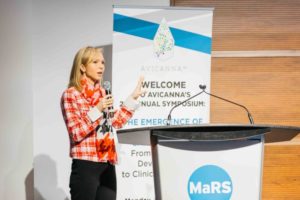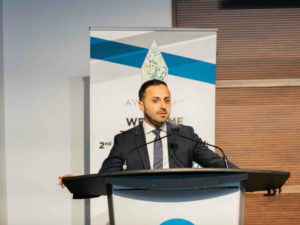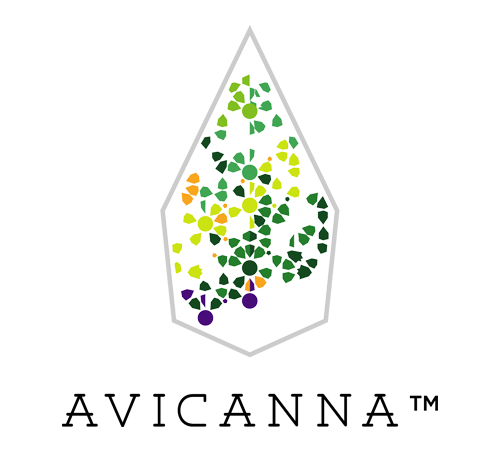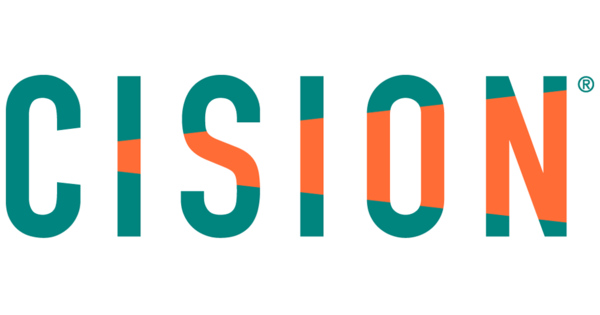The emergence of biopharmaceutical cannabinoids: From R&D through clinical translation
Seminar plots strategy for reaping therapeutic benefits of cannabinoids, emphasizing that quality cannabis research is a must to avoid experimenting with millions of people
Cannabis is now a point of conversation in many different verticals: research, medical, health and business being among a long list of existing and emerging partners. With so much changing so very quickly, advancing expeditiously—while still taking the time to set a strategic course—should serve those in cannabis and cannabis-related industries well moving forward.
All such considerations were on offer at a symposium hosted by Avicanna Inc.—which conducts advanced cannabinoid research, manufactures a range of cannabinoid-based pharmaceuticals and therapeutics, and operates cannabis cultivation projects in Colombia—at the MaRS Discovery District in downtown Toronto on Mar. 25
How important is good science?
Dr. Christine Allen, chief scientific officer with Avicanna, is a strong believer in the need for good science, especially in the medical cannabis industry and especially now. The two most studied cannabinoids—CBD and THC—are beginning to be considered a “cure-all” for nearly every minor ailment or chronic condition, suggested Dr. Allen, also a professor with the Faculty of Pharmacy at the University of Toronto.
“Is this cause for concern? And does the scientific data and medical evidence support the current level of interest and investment in this area?” she asked. “These kinds of basic, difficult questions must be asked up front or the consequences can be catastrophic. If we don’t, we will be conducting an uncontrolled experiment on millions and millions of people,” she told attendees.
To support her growing concern about safety issues, Dr. Allen cited a recent study published in Obstetrics & Gynecology. Researchers posing as expectant mothers had surveyed 400 cannabis retail outlets and dispensaries operating in Colorado and learned the majority of them—69.2 percent—were recommending using various cannabis products to treat morning sickness during the first trimester. That total included a jaw-dropping 83.1 percent of dispensaries licensed for the sale of medical cannabis.

Dr. Christine Allen, chief scientific officer for Avicanna Inc. and professor and dean of the Leslie Dan Faculty of Pharmacy at the University of Toronto, addresses those gathered for the recent symposium at the MaRS Discovery District in downtown Toronto.
Perhaps more troubling, less than one-third of the dispensaries advised callers to talk to their health care providers despite documented adverse effects of THC on both perinatal outcomes and foetal neurodevelopment. “Just because a product has been approved for sale does not mean it is either safe or effective in treating certain medical conditions,” Dr. Allen argued.
This holds true for both medical and recreational cannabis. “Good news for the recreational market is good news for the medical market,” she said, “and bad news for one is bad news for the other.” Whether a person is dealing with a prescribed medicine, a topical lotion or a THC-infused lollipop, “ensuring the quality and safety of that product is primary,” she insists. “We must be responsible.”
Dr. Allen called for accurate product labelling, training and educating dispensers and consumers, and compiling product performance data to determine a product’s effectiveness.
What are some research quality concerns?
“If you want quick results [on cannabis clinical research], work on pain relief,” recommended Dr. Humberto Reynales, founder and executive director of CAIMED (Centro de Atención e Investigación Médica), a private clinical research organization in Latin America. If upper management is satisfied with longer-term work, “look at Parkinson’s, or MS (multiple sclerosis) or maybe a type of disease,” Dr. Reynales advised. Whatever the area of study, he stressed the need for “well-designed clinical studies to create strong evidence of the medical effectiveness of cannabis.”
Dr. Reynales reviewed some 1,400 scientific research papers indexed on PubMed—the online database of the U.S. National Library of Medicine—detailing the therapeutic effects of, and linkages between, cannabinoids and a number of medical conditions, including Alzheimer’s disease, amyotrophic lateral sclerosis (ALS), MS, cancer, diabetes, neuropathic pain, PTSD, schizophrenia and psychosis, and various degenerative diseases.
Cannabinoids have displayed a broad range of potential therapeutic benefits, but not all are useful and more research is needed in this area, he maintained. Other cannabinoids—such as CBG, CBC, THC and non-psychoactive THC-A should also be considered, he said. “But in more than 90 percent of the clinical trials, the cannabis used didn’t have the components at the levels the researchers originally thought it did,” he said.

Aras Azadian, CEO and director of Avicanna Inc., explains to symposium attendees that the cannabis industry is witnessing one of the largest paradigm shifts since the dot-com revolution.
Dr. Reynales also found that many of the trials conducted to date have been done with full spectrum rather than purified cannabinoids. This means some of the documented benefits could be the result of synergistic reactions among various cannabinoids, terpenes and other compounds—the so-called entourage effect.
Is Canada’s leadership in cannabis research slipping away?
“We are at a very unique moment in our industry, witnessing one of the largest paradigm shifts since the dot.com revolution,” commented Avicanna CEO Aras Azadian. “As the first G7 country to legalize, first medical and now recreational cannabis, Canada has established itself as a forerunner in the sector,” Azadian told attendees. However, the country is at a crossroads and risks “losing our position as global pioneers,” he warned.
“Our leadership position can be attributed to early access to financing and capital markets,” he explained, reporting that the Toronto Stock Exchange (TSE) and the Canadian Securities Exchange (CSE) were the first stock exchanges to approve cannabis listings. In 2018, Canadian cannabis firms raised $11.8 billion dollars, compared to just $627 million for all the other cannabis companies in the rest of the world, he reported.
Despite those positives, Azadian told attendees “too much of this capital has been invested into capex (capital expenditures) indoor facilities” to grow cannabis year-round in Canada’s inhospitable climate. “These factories and warehouses cannot compete on a cost per kilogram basis with cannabis grown outdoors in South America, for example,” he argued.
“The new low-tech greenhouses are also more environmentally sustainable and generate the same yields at a fraction of the cost,” Azadian added, claiming outdoor crops can be cultivated for $50 a kg compared to $2,000 per kg for some factory-raised cannabis. The bottom line: “No one cares where the components of a pharma product come from,” he said.
And while much money has been spent on buildings and facilities, not enough has been devoted to research and development and clinical development over recent years, Azadian maintained. “There has also been limited product offerings and prioritization of the recreational market,” he said.
Where is the collective understanding of cannabis?
From the perspective of the pharmaceutical industry, what we know about the [cannabis] plant “is still very primitive,” warned Samantha Watt, vice president of scientific affairs for Avicanna. “When we’ve seen other companies come out and try to synthetically mimic these compounds, more times than not, the results have not been all that great… You don’t know what you might be getting,” Watt noted during the panel discussion, Natural Cannabinoid Active Pharmaceutical Ingredients: From Seed to API.
There are also risks related to the genetic modification of plants. “If you are looking to acquire resins that are abundant in one kind of cannabinoid, you are redirecting the actual genetics and the carbon flow of the plant,” she explained. As a result, the plant could also be producing new toxins and other compounds that “we don’t know anything about yet, compounds that down the line could cause actual harm to the individual.”
Is the path forward plants or biotech?
A panel discussion with investment professionals found a split in support between plant-derived cannabinoids and biosynthetic compounds, although everyone agreed that future production of APIs from whatever source must be pure, clean, consistent and low cost. “It is cost prohibitive for any company to extract minor cannabinoids—CBN, CBG, CBD or THC—from plants,” argued David Kideckel, managing director of AltaCorp Capital Inc.’s health care and life sciences research group. Kideckel’s view is that biosynthetic production of cannabinoids is going to be “a very big deal.”
“We don’t view this as, necessarily, a competition between plant-derived companies and biosynthetics firms,” he told attendees. “Instead, we see them working together, side-by-side and enjoying a lot of synergies.”
Not everybody agrees. Alan Ridgway, a research analyst with Sprott Capital Partners, happily “threw a wrench” into the discussion. “By moving 100 percent into biotech, all of a sudden you are dealing with a synthetic molecule instead of a plant-derived molecule,” Ridgeway explained. “You lose your wellness aspect, you lose your supplement aspect and you lose your over-the-counter aspect.”
Instead, makers get drawn into the U.S. Food and Drug Administration and Health Canada bureaucracies, where they are subject to all the toxicology and preclinical study requirements despite, for example, “working with a CBD that came out of an algae or yeast or bacteria,” he said. Although there may be some minor biosynthetic cannabinoids that potentially may be “important drugs on the pharma side,” Ridgeway said he has avoided recommending them as plays to investors.
That said, he noted he is excited with new opportunities on the genetics front, especially with the passage of the U.S. Farm Bill. “You are going to see a number of genetics and breeding companies pushing very hard down the path to produce high-CBD hemp plants,” he predicted. Although THC content will be limited to less than 0.3 percent, Ridgeway expects to see the development of hemp strains containing high concentrations of all the other cannabinoids, including trial plantings of a 16 percent CBG strain and a 10 percent CBC stabilized strain.
This is not the industrial hemp grown in Canada, Ridgeway cautioned. “Five to 10 years down the road, Canadian producers are going to have to compete on price with the low cost, outdoor hemp producers that will be supplying the cannabinoid ingredients in consumer wellness products, topical lotions and over-the-counter products,” he said.
“The current weed shortages will be temporary,” Kideckel predicted. “Instead, there is going to be oversupply and a lot of price suppression.” As production continues to kick up to meet demand, he noted the conversation will shift to product branding, which could be tough for Canadian cannabis companies trying to out-market retailers and brands in, say, California, and facing Health Canada’s “overly restrictive” marketing and packaging rules.





